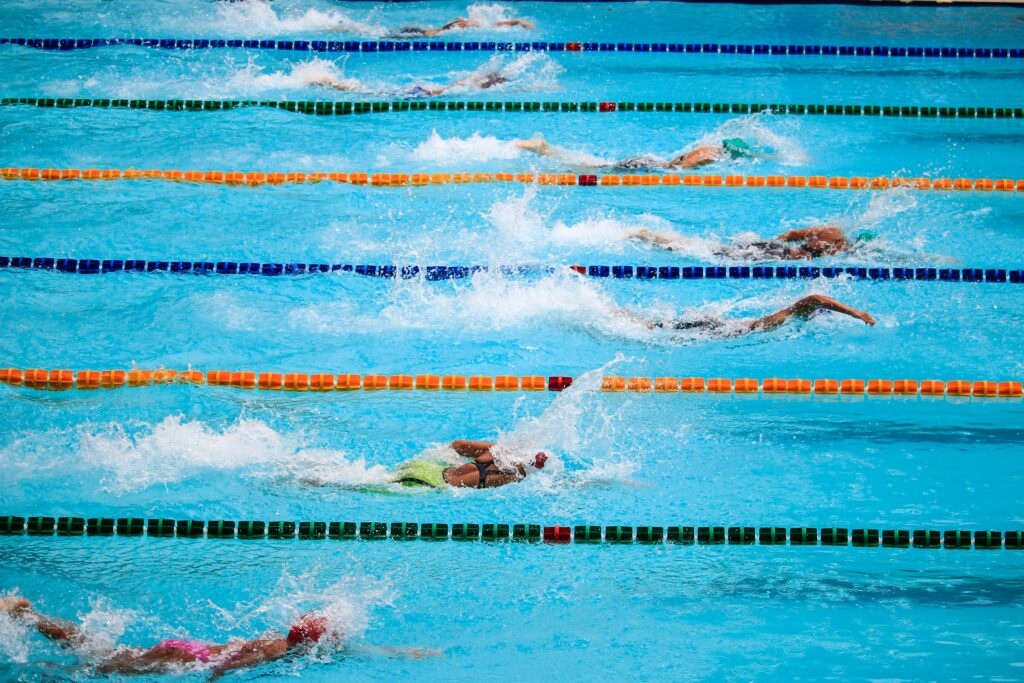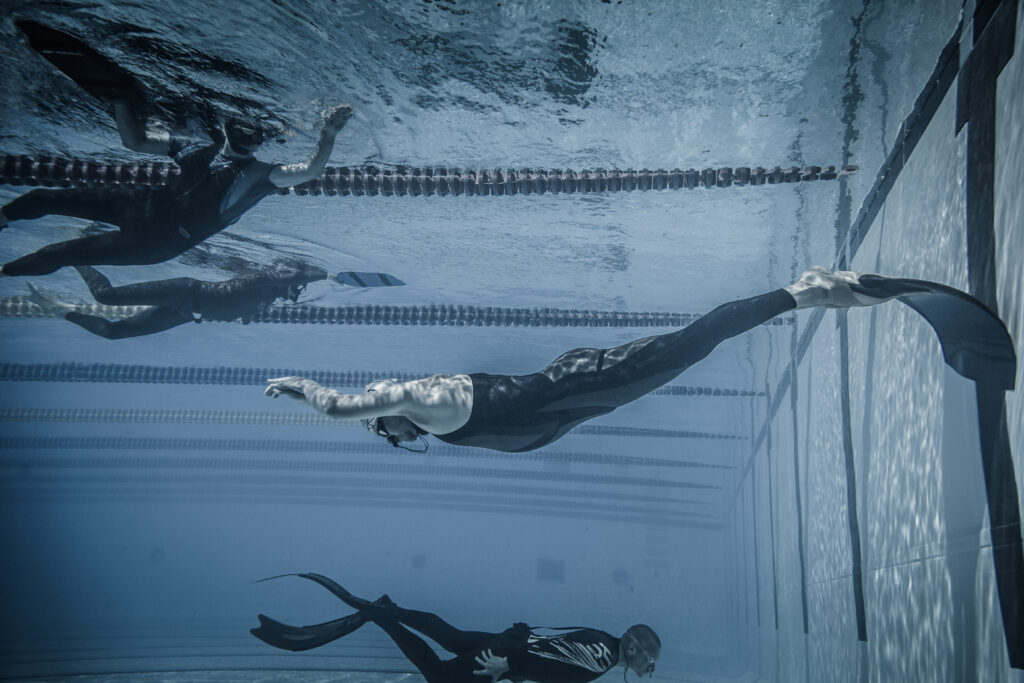Tech suits have become increasingly popular in competitive swimming in recent years. These suits are specifically designed to enhance performance and are made with advanced materials that reduce drag and increase buoyancy. But do tech suits actually make you swim faster?
According to a study conducted by Swim Competitive, tech suits were able to significantly improve swimming times with an average improvement of 0.4 seconds in high resistance strokes and 0.52 seconds in low resistance strokes. The study concluded that the suits’ advanced materials and design features help to reduce drag and increase buoyancy, leading to faster swim times.
While the science behind tech suits is promising, there is still some controversy and discussion surrounding their use in competitive swimming. Some argue that the suits provide an unfair advantage, while others believe that they are a necessary tool for elite swimmers looking to improve their performance. In this article, we’ll take a closer look at the science behind tech suits and explore their use in competitive swimming.
Key Takeaways
- Tech suits have been shown to significantly improve swimming times by reducing drag and increasing buoyancy.
- There is still some controversy surrounding the use of tech suits in competitive swimming.
- While tech suits may provide an advantage, they are also a necessary tool for elite swimmers looking to improve their performance.
Understanding Tech Suits
Tech suits are specially designed swimsuits that are worn by competitive swimmers to enhance their performance. These suits are made up of advanced materials that are designed to reduce drag and improve hydrodynamics. In this section, we will take a closer look at the various features of tech suits that make them so effective.
Materials and Design
Tech suits are typically made from a combination of materials such as nylon, spandex, and polyester. These materials are chosen for their ability to provide compression, flexibility, and durability. The design of tech suits is also an important factor in their effectiveness. The seams of the suit are strategically placed to reduce drag, and the suit is designed to be tight-fitting to reduce water resistance.
Compression and Hydrodynamics
One of the key features of tech suits is their ability to provide compression. Compression is the application of pressure to specific parts of the body to improve blood flow and reduce muscle vibration. In a tech suit, compression is used to improve hydrodynamics by reducing the amount of water resistance that the swimmer experiences. This allows the swimmer to move through the water more efficiently, which can lead to faster swimming times.
Water-Repellency and Drag Reduction
Another important feature of tech suits is their ability to repel water and reduce drag. The materials used in tech suits are designed to be water-repellent, which means that they do not absorb water. This reduces the amount of water that the swimmer has to push through, which can lead to faster swimming times. Additionally, the design of the suit is meant to reduce drag by minimizing the amount of fabric that is exposed to the water.
In conclusion, tech suits are designed to help competitive swimmers improve their performance by reducing drag and improving hydrodynamics. They are made from advanced materials and designed to be tight-fitting, water-repellent, and compressive. These features work together to help swimmers move through the water more efficiently, leading to faster swimming times.
The Science Behind Tech Suits
Tech suits have become increasingly popular among competitive swimmers in recent years. This section will explore the science behind tech suits, including their physiological and psychological effects.
Physiological Effects
Research has shown that tech suits can have several physiological effects on swimmers. One of the main benefits of tech suits is their ability to reduce drag in the water. This is achieved through the use of hydrophobic materials, which repel water and reduce friction between the swimmer and the water. This reduction in drag can result in faster swimming times, as less energy is required to move through the water.
Tech suits can also have a positive impact on a swimmer’s muscle activation and blood flow. The compression provided by the suit can improve circulation and blood flow to the muscles, which can help to reduce the buildup of lactic acid. This, in turn, can delay the onset of fatigue and improve endurance.
Psychological Effects
In addition to their physiological benefits, tech suits can also have psychological effects on swimmers. The compression provided by the suit can create a feeling of support and stability, which can help to boost confidence and reduce anxiety. This can be particularly beneficial for swimmers who struggle with performance anxiety or nerves before a race.
However, it is important to note that the psychological effects of tech suits can be a double-edged sword. While some swimmers may benefit from the added confidence and support, others may become overly reliant on the suit and struggle to perform without it. It is important for swimmers to strike a balance between using tech suits as a performance-enhancing tool and developing their own skills and abilities.
Overall, the science behind tech suits suggests that they can have several physiological and psychological benefits for competitive swimmers. However, it is important for swimmers to use tech suits responsibly and in conjunction with proper training and technique development.
Performance Enhancement with Tech Suits
Tech suits have become increasingly popular among competitive swimmers, but do they actually make you swim faster? The answer is yes, but the extent to which they enhance performance depends on various factors such as the swimmer’s skill level, stroke technique, and race distance. In this section, we will explore how tech suits can improve swimming speed, efficiency, stroke rate, buoyancy, and body alignment.
Swimming Speed and Efficiency
Tech suits are designed to reduce drag and improve hydrodynamics. They are made of hydrophobic materials that repel water, reducing the swimmer’s surface area and friction. This allows swimmers to move through the water with less resistance, resulting in faster swimming speeds. Additionally, tech suits compress the body, reducing muscle oscillation and energy expenditure, which enhances swimming efficiency.
Stroke Rate and Length
Swimming with a tech suit can also improve stroke rate and length. The compression of the suit helps to maintain a streamlined body position, reducing drag and allowing for a faster stroke rate. Swimmers can also achieve a longer stroke length by using the extra buoyancy provided by the suit to maintain a more horizontal position in the water. This allows for a greater reach and pull through the water, resulting in a more powerful stroke.
Buoyancy and Body Alignment
Tech suits provide additional buoyancy, which can help swimmers maintain a more efficient body position in the water. The added buoyancy raises the hips and legs, reducing drag and allowing for a more streamlined body position. This also helps to maintain a more horizontal body alignment, which reduces resistance and allows for a more efficient stroke.
In conclusion, tech suits can enhance swimming performance by improving speed, efficiency, stroke rate, buoyancy, and body alignment. However, it is important to note that the effectiveness of tech suits varies depending on the swimmer’s skill level, stroke technique, and race distance. While tech suits can provide a competitive advantage, it is important to use them in conjunction with proper training and technique to maximise their benefits.
Tech Suits in Competitive Swimming
Tech suits have become increasingly popular in competitive swimming in recent years. These suits are designed to enhance physical performance in the water, giving swimmers a competitive edge. In this section, we will explore the FINA regulations surrounding tech suits, their impact on world records and elite swimmers, and their use in swim meets and events.
FINA Regulations
FINA, the international governing body for swimming, has strict regulations on the use of tech suits in competition. These regulations are in place to ensure that all swimmers have a fair and equal chance to compete. According to FINA rules, tech suits must meet certain criteria to be approved for use in competition. These criteria include the thickness and buoyancy of the material, as well as the design and construction of the suit.
World Records and Elite Swimmers
Tech suits have had a significant impact on world records and elite swimmers. These suits are designed to reduce drag and increase buoyancy, allowing swimmers to move more efficiently through the water. Many world records have been broken by swimmers wearing tech suits, and elite swimmers often use these suits in competition to give them a competitive edge.
Swim Meets and Events
Tech suits are commonly used in swim meets and events, especially at the elite level. These suits are often worn by swimmers competing in finals or championship events, where the stakes are high. However, the use of tech suits in competition has been a topic of controversy in recent years. Some argue that these suits give swimmers an unfair advantage, while others believe that they are simply a tool to enhance performance.
In conclusion, tech suits have become an integral part of competitive swimming, with many swimmers relying on them to give them a competitive edge. While there are regulations in place to ensure fair competition, the use of tech suits continues to be a topic of debate in the swimming community.
Comparing Tech Suits with Standard Training Suits
When it comes to competitive swimming, the right gear can make a significant difference in performance. One of the most debated topics in the swimming community is whether tech suits make you swim faster than standard training suits. In this section, we will compare tech suits and standard training suits based on factors such as speed and time differences, durability, and sizing.
Speed and Time Differences
According to a study by Swim Competitive, tech suits can reduce drag by approximately 4.4% to 6.2% and greatly reduce the energy cost of swimming by about 4.5% to 5.5%. The compression provided by tech suits increases muscle activation, resulting in higher power output. Additionally, tech suits are buoyant, which can raise your hips in the water and give you the sensation of swimming “downhill.” All of these factors combined can result in faster swim times.
On the other hand, standard training suits are typically made of polyester and do not provide the same level of compression or buoyancy as tech suits. This can result in slower swim times and less efficient swimming technique.
Durability and Sizing
Tech suits are designed to be worn for short periods during competition and are not as durable as standard training suits. They are made with high-tech materials that can be easily damaged by chlorine and other chemicals found in pool water. Standard training suits, on the other hand, are made with more durable materials and can withstand the wear and tear of daily training sessions.
Sizing is also an important factor to consider when choosing between tech suits and standard training suits. Tech suits are designed to fit tightly and compress the muscles, which can make them uncomfortable to wear for extended periods. Standard training suits are typically more comfortable and easier to move in, but may not provide the same level of compression and buoyancy as tech suits.
In conclusion, tech suits can make a significant difference in swim performance by reducing drag, increasing muscle activation, and providing buoyancy. However, they are not as durable as standard training suits and may not be as comfortable to wear for extended periods. When choosing between tech suits and standard training suits, it is important to consider factors such as swim goals, budget, and personal preferences.
Notable Tech Suits and Swimmers
LZR Racer and Michael Phelps
One of the most iconic tech suits in swimming history is the LZR Racer, which was developed by Speedo in 2008. The suit was famously worn by Michael Phelps during the Beijing Olympics, where he won eight gold medals and set seven world records. The LZR Racer was designed to reduce drag and improve buoyancy, and it was made from a combination of polyurethane and spandex.
Phelps was not the only swimmer to benefit from the LZR Racer. In fact, the suit was worn by the majority of swimmers at the Beijing Olympics, and it was credited with helping athletes break numerous world records. However, controversy soon followed, as many people argued that the suit provided an unfair advantage. In response, FINA, the international governing body for swimming, banned suits made from non-permeable materials, effectively rendering the LZR Racer illegal.
Jammers and Caeleb Dressel
Jammers are a type of tech suit that are popular among male swimmers. They are designed to be worn like shorts and cover the entire leg, providing compression and reducing drag. One swimmer who has had great success wearing jammers is Caeleb Dressel. Dressel is a multiple-time Olympic gold medallist and world record holder, and he is known for his explosive speed and power in the water.
Dressel has worn a variety of different jammers throughout his career, but one of his favourites is the Arena Carbon Air. This suit is made from a lightweight, breathable fabric that provides compression without restricting movement. Dressel has credited the Carbon Air with helping him swim faster and break records, and it is a popular choice among many elite swimmers.
Overall, while tech suits can certainly provide a performance boost, it is important to note that they are not a magic solution. Swimmers still need to put in the hard work and training to achieve their goals. However, for those looking to gain an extra edge, a high-quality tech suit can certainly make a difference.
Controversies and Discussions
The Rubber Suits Era
The introduction of rubber suits in the 1950s revolutionized swimming, but it also sparked a debate about the use of performance-enhancing suits in competitions. The use of rubber suits was eventually banned in 1967, but the controversy around performance-enhancing swimwear continued.
In 2008, the introduction of full-body polyurethane swimsuits caused a stir in the swimming world. These suits were found to significantly reduce drag and improve buoyancy, resulting in faster swimming times. However, the suits were very expensive and only a few swimmers could afford them. The suits were also criticized for their performance-enhancing characteristics, leading to their eventual ban in 2010.
Expensive and Performance-Enhancing Characteristics
The cost of tech suits is a significant barrier for many swimmers. Tech suits can cost several hundred pounds, making them unaffordable for many. The high cost of tech suits has led to concerns about the fairness of competitions, as only a few swimmers can afford to wear them.
Tech suits are designed to improve a swimmer’s performance by reducing drag and improving buoyancy, among other characteristics. However, the performance-enhancing characteristics of tech suits have led to debates about their use in competitions. Some argue that the use of tech suits gives an unfair advantage to swimmers who can afford them, while others argue that they are necessary for top-level competition.
In conclusion, the use of tech suits in swimming competitions has been a controversial topic for many years. The introduction of rubber suits and full-body polyurethane swimsuits sparked debates about the fairness of performance-enhancing swimwear. The high cost of tech suits has also raised concerns about the accessibility of competitive swimming.
Conclusion
In conclusion, tech suits can help improve swimming performance by reducing drag and improving streamline. They are designed with panels and tape that compress the body and make it more streamlined in the water, reducing drag and wave turbulence. The compression effects of tech suits can also help swimmers swim faster by increasing distance per stroke and stroke rate.
However, it’s important to note that tech suits are not a magic solution to improve swimming performance. They should be used in combination with structured swim workouts and goal-orientated training plans to achieve the best results. Additionally, the cost of tech suits can be quite high, and their benefits may not outweigh the cost for recreational swimmers.
Overall, tech suits can be a useful tool for competitive swimmers looking to improve their performance, but they should be used in conjunction with other training methods and should be considered carefully before making a purchase.
Frequently Asked Questions
How do tech suits improve swim times?
Tech suits are designed to reduce drag and improve buoyancy, which helps swimmers move through the water with less resistance. The compression of the suit also helps to support the muscles, reducing fatigue and increasing endurance. The combination of these factors can result in faster swim times.
What are the benefits of wearing a tech suit?
Wearing a tech suit can provide a range of benefits for swimmers. In addition to improving swim times, tech suits can also help with body positioning, reduce drag, and increase endurance. The compression of the suit can also help to reduce muscle fatigue, making it easier to maintain good technique throughout a race.
What is the difference between a tech suit and a regular swimsuit?
The main difference between a tech suit and a regular swimsuit is the level of compression and the materials used. Tech suits are designed to be more aerodynamic and to reduce drag, while regular swimsuits are designed primarily for comfort and ease of movement. Tech suits are also made from high-tech materials that are designed to be more durable and resistant to wear and tear.
Are tech suits legal in all swimming competitions?
While tech suits are legal in most swimming competitions, there are some restrictions on the types of suits that can be worn. For example, FINA (the international governing body for swimming) has specific rules about the types of materials that can be used in tech suits, and some competitions may have additional restrictions on the use of tech suits.
Do tech suits have a specific lifespan?
The lifespan of a tech suit can vary depending on how often it is used and how well it is cared for. Most tech suits are designed to last for a certain number of races (usually around 10-12), but this can vary depending on the brand and model of the suit. It is important to follow the manufacturer’s instructions for care and maintenance to ensure that the suit lasts as long as possible.
Can wearing a tech suit help with buoyancy and body positioning in the water?
Yes, wearing a tech suit can help with buoyancy and body positioning in the water. The compression of the suit helps to support the muscles and keep the body in a more streamlined position, which can reduce drag and improve swim times. The buoyancy of the suit can also help to keep the body in a more horizontal position, which can further reduce drag and improve swim times.






